
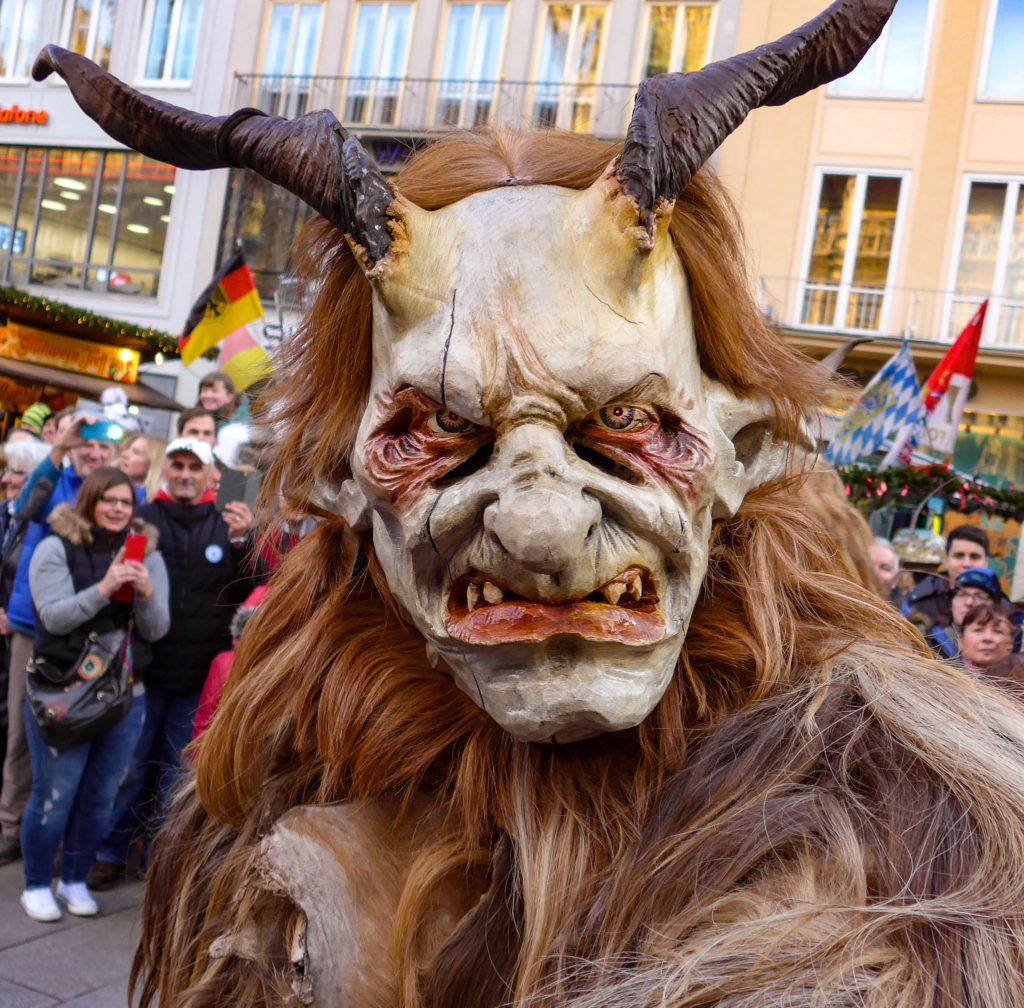
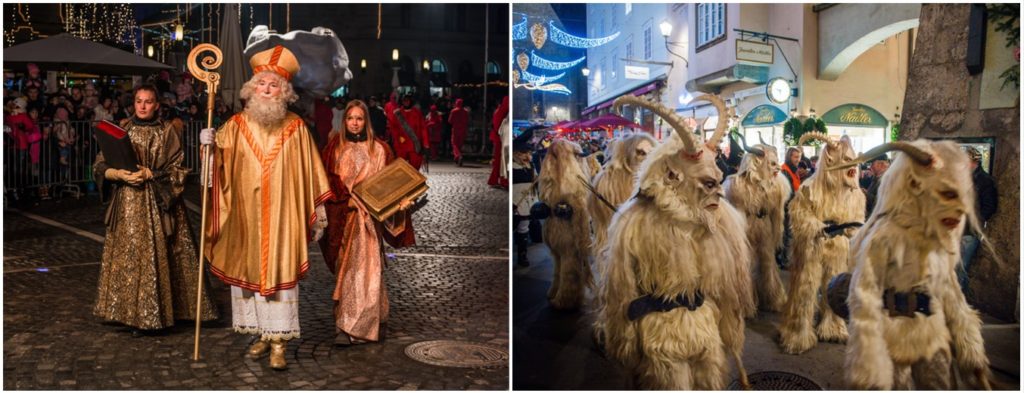
Every year in early December, children in Germany and Austria anxiously prepare for a visit from St. Nicholas. Those who were good will be rewarded with presents and treats, but those who misbehaved will face his menacing partner, Krampus, the devilish figure who beats naughty children and drags them off to hell!
Neither fat, nor jolly, nor born in the north pole, the real-life St. Nicholas was a Greek born bishop in the late third century, who served in Myra, a small Roman town in what is now modern-day Turkey. Known for his wealth and generosity, he developed a reputation for helping people in need.
Of his many charitable acts, most famous is the story of how he helped a poor man with three daughters. Without money for their dowries, the girls would be unable to get married, and therefore were doomed to a life of prostitution or slavery. Legend has it that one night, Nicholas secretly dropped a bag of gold down the man’s chimney into his house, where it landed in a stocking that had been hung by the fire to dry. This served as dowry for the oldest daughter. Later, a second bag of gold came down the chimney, saving the middle daughter. Finally, the man was so determined to find out who had given him the money, that he hid by the chimney every evening waiting for the gold that would undoubtedly come to save his youngest daughter; finally he caught Nicholas. Though Nicholas begged the man not to reveal his identity, word eventually got out and any time someone received a secret gift, they believed it was from the good bishop.
Many true stories of Saint Nicholas’ good deeds are now so mixed with legend that it’s difficult to separate fact from fiction. However, what is known of the saint is that he was a fierce defender of church doctrine during the Great Persecution in 303, when Bibles were burned and priests were forced to renounce Christianity or face execution. Defiant, he spent several years in prison before Roman emperor Constantine ended the Christian persecution in 313. Nicholas also earned fame for his association with several miracles. In sainthood, he is the protector of many types of people, from orphans to sailors to prisoners.
Today, St. Nicholas’ Day is celebrated in his honor on December 6, the anniversary of his death in the mid fourth century. On this day, children in Central Europe hang stockings or put out their shoes hoping for a gift from the generous saint.
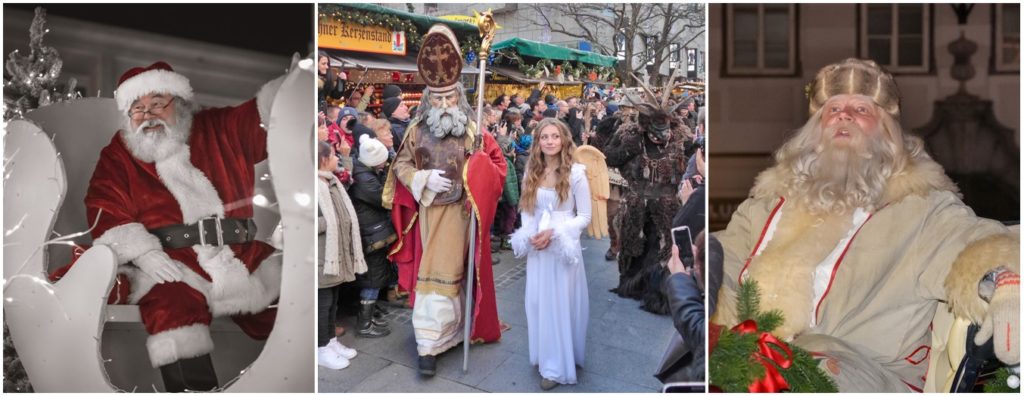
Not exactly. Santa Claus is an American invention, an amalgamation of European history and tradition and American storytelling; the result of European immigrants (primarily of Dutch, British, and German origin) sharing their customs and traditions and blending them in the melting pot of 19th century America. The American image of Santa Claus comes primarily from the poem, “A Visit from St. Nicholas” by Clement Clark Moore which describes Saint Nicholas as a “jolly old elf” dressed all in fur, with a round belly, white beard, and rosy cheeks. That poem was the inspiration for artist Haddon Sundblom who created the modern image of Santa for Coca Cola’s 1931 “Thirst Knows No Season” advertising campaign. This newly depicted vision St. Nicholas laid the foundation for our present-day Santa Claus.
The name Santa Claus evolved from the Dutch nickname for Saint Nicholas, Sinterklaas, a shortened form of Sint Nikolaas (Saint Nicholas). Santa’s nickname, Kris Kringle, can be traced back to the German Kristkindl or Chirstkindl, which translates directly to Christ Child. In Germany, the Christ Child is a gift bearing angel, the spirit of Christmas, who delivers presents on Christmas. This tradition was made popular by protestant reformer Martin Luther in the 16th century. In general, as Protestantism flourished, Catholic traditions such as Saints’ Days declined, thus boosting the popularity of gift-giving alternatives to St. Nicholas, such as Santa Claus.
Other alternatives to St. Nicholas include Grandfather Frost, known in Slovenian as Dedek Mraz. Grandfather Frost, also referred to as Grandfather Cold, originated from the pagan culture of the Eastern Slavs, and was introduced to Yugoslavia by Russian communist society as a secular alternative to western beliefs. Grandfather Frost is frequently depicted as a slim man wearing a long white coat and brown furry Russian kučma hat. He hands out gifts at gatherings on New Year’s Eve. But, be careful not to confuse the Eastern European Grandfather Frost with British Father Christmas, who originated as a pagan bringer of spring. Influenced first by a Viking invasion, and later by a Norman invasion, Father Christmas shares many of the characteristics of other European Christmas characters. He is portrayed as an old man, with a long white beard and a blue hooded cloak who gives gifts to good children.
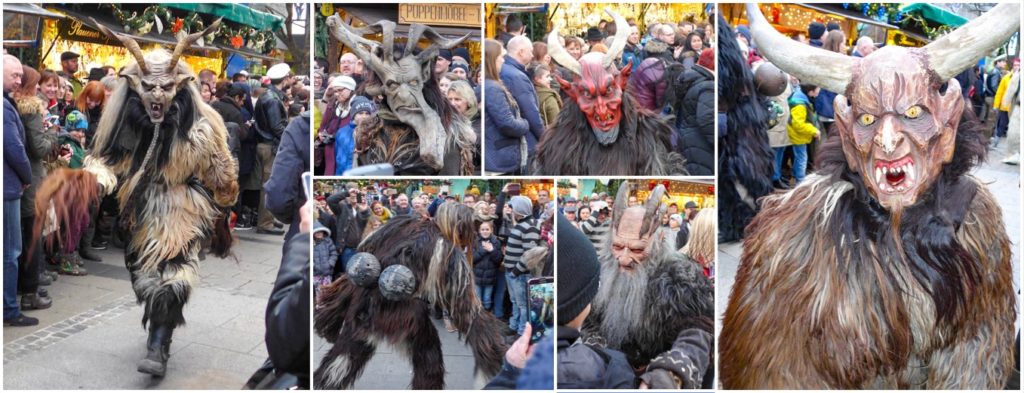
So how does Krampus fit into this equation? In central European tradition, St. Nicholas is traditionally accompanied by an evil, or at least mischievous, partner. St. Nicholas bestows gifts to well behaved children, while his companion doles out punishment to those that were naughty. Through most of Germany, St. Nicholas is assisted by a character named Knecht Ruprecht, in Switzerland by Schmutzli, in France and Luxembourg by Père Fouettard, in the Netherlands by Zwarte Piet, and in Slovenia by Parkelj. In Southern Germany and Austria, St. Nicholas’ counterpart is Krampus.
Krampus has origins in pagan celebrations of the winter solstice. He name is derived from an old Germanic word for “claw,” and he is said to be the son of Hel, who rules the realm of the dead in Norse mythology. Krampus is described as being an anthropomorphic figure, half-goat, half-demon, sharing many of the characteristics of fiendish creatures in Greek mythology, including satyrs and fauns. He has long horns, claws, and a goat-like beard. He beats children with birch branches or kidnaps them in his sack and takes them to his lair. Krampus’ original, pre-Christian incarnation may have been intended to watch over humans and protect them, scaring away bad ghosts and helping people overcome fear, similar to the Austrian character Perchta. Perchta was a female figure in Alpine paganism, a dual-faced goddess, both fair and ugly, dark and light. Eventually her name was also taken by the evil creatures that accompanied her, Perchten, and the custom developed that the young men of the villages would dress in furs and fearsome masks and roam from house to house to scare away evil spirits. These days, Krampus and Perchta have become largely conflated, their origins and physical traits blending, the distinction between the two becoming more and more blurred.
Throughout history, the Catholic Church and conservative Christian parties have made attempts to banish Krampus and Perchten celebrations due to their resemblance to the devil. During the inquisition, it was forbidden to masquerade as a devil and punishable by death. Because of this, the custom only survived in extremely remote and inaccessible regions of the Alps. From there, it slowly spread over the region again, increasing in popularity, and in recent years even gaining recognition overseas. Austrian actor Christoph Waltz famously joked about the tradition in a 2014 interview on the Tonight Show Starring Jimmy Fallon, saying that, “St. Nicholas comes with praise and presents and wisdom, and Krampus with a stick, a bag, and he threatens you… if you weren’t good you get stuck in the bag and hit and shipped off.” In 2015, Krampus hit the big screen in a blockbuster horror film. Despite this, the tradition is still mostly unknown to Americans.
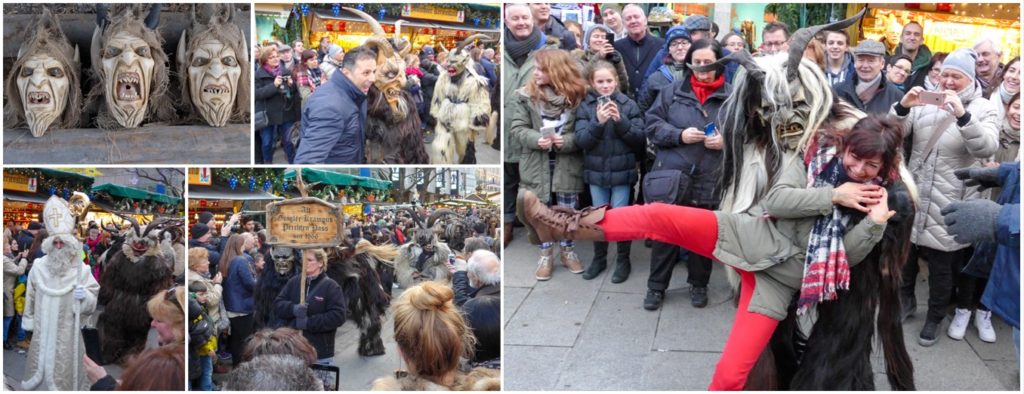
Today, the best way to experience this centuries-old folk custom is by attending a Krampuslauf, literally, a Krampus Run. Krampus runs are normally held from mid-November to mid-December (many on December 5th or 6th coinciding with St. Nicholas’ Day) in the Alpine region that includes southern Bavaria, southern Austria, and Slovenia. In bigger cities, such as Munich and Salzburg, these Krampus Runs take the form of parades which march through the central Christmas Market. The processions feature members of the local Krampuspassen (Krampus clubs or associations financed by local business sponsors) dressed in elaborate costumes, sporting hand-carved wooden masks, shaggy pelts, and clanging cow bells, running and stomping down the street. It’s an immersive experience, with the performers often pulling spectators into the procession, tussling their hair or swatting them with a switch made of birch sticks.
A Krampuslauf could be made up of up to 300 costumed participants, each portraying a specific role. The Krampuspassen each designate on person to carry a sign bearing the association’s name and locality, for example the Alt Gnigler Krampus Perchten Pass as pictured above. Following that, the procession is led by St. Nicholas, sometimes accompanied by the Christkindl. Behind him lurk an array of Krampusse (plural of Krampus) and Perchten, as well as Hexen (witches) and other figures from Alpine folklore. Krampusse can be distinguished by masks bearing 2 horns, Perchten normally have 4 to 10 horns. The intricate costumes are a truly a work of art, sometimes costing up to 2,500 Euro each. Of the hand carved wooden masks, no two are exactly alike, and each display extraordinary craftsmanship. The majority are made using mostly natural materials such as pine wood, driftwood, horse hair, animal teeth, furs, and horns from alpine creatures. Some masks are so lifelike, it’s hard to imagine that they aren’t real… then again, it is said that at every Krampuslauf, there is actually one real Percht among the imposters. So, when you observe these wild characters from a safe distance, keep a close eye. Did he blink? Did an ear twitch? Was that just the wind? It may be more than just tradition which is alive.